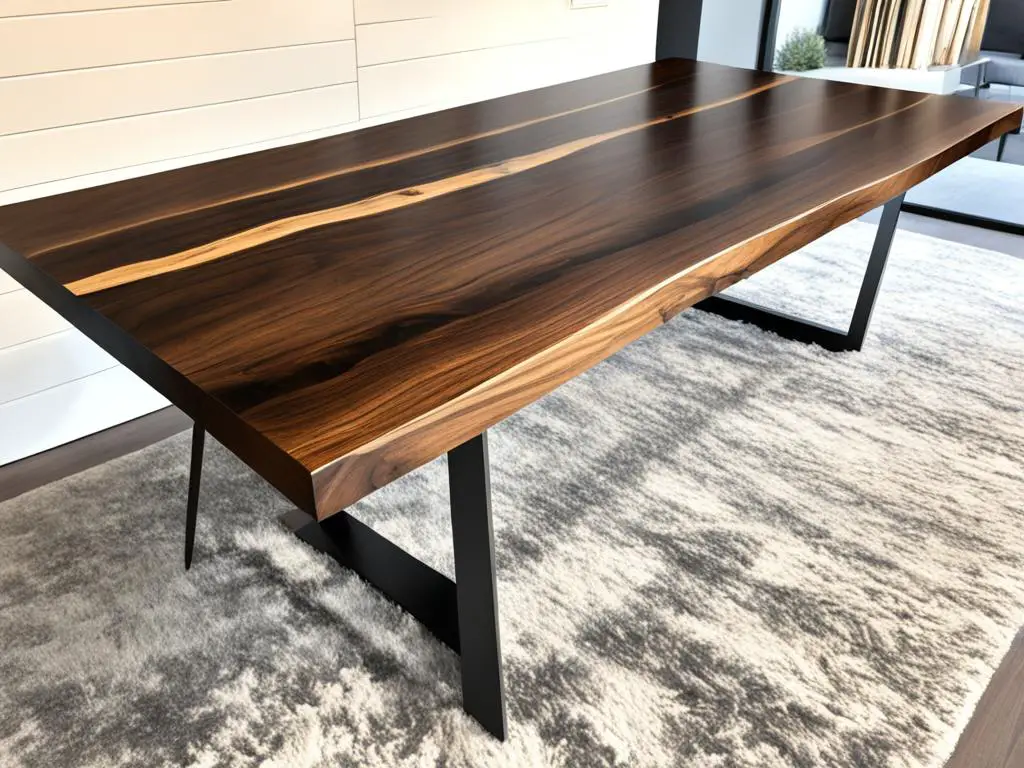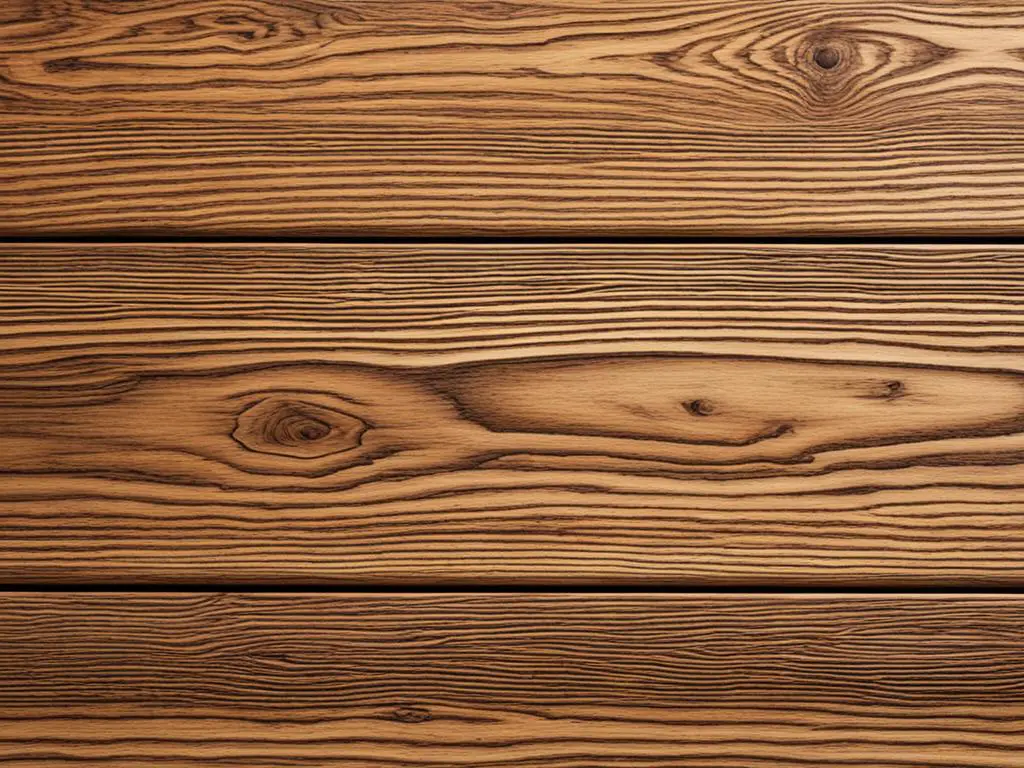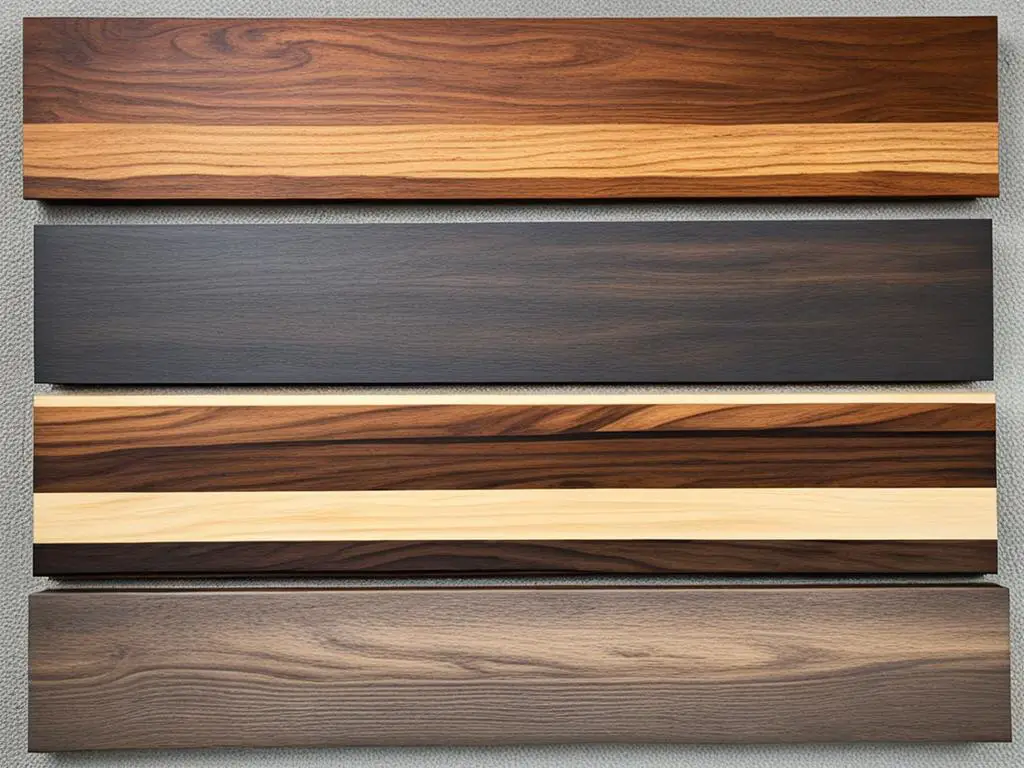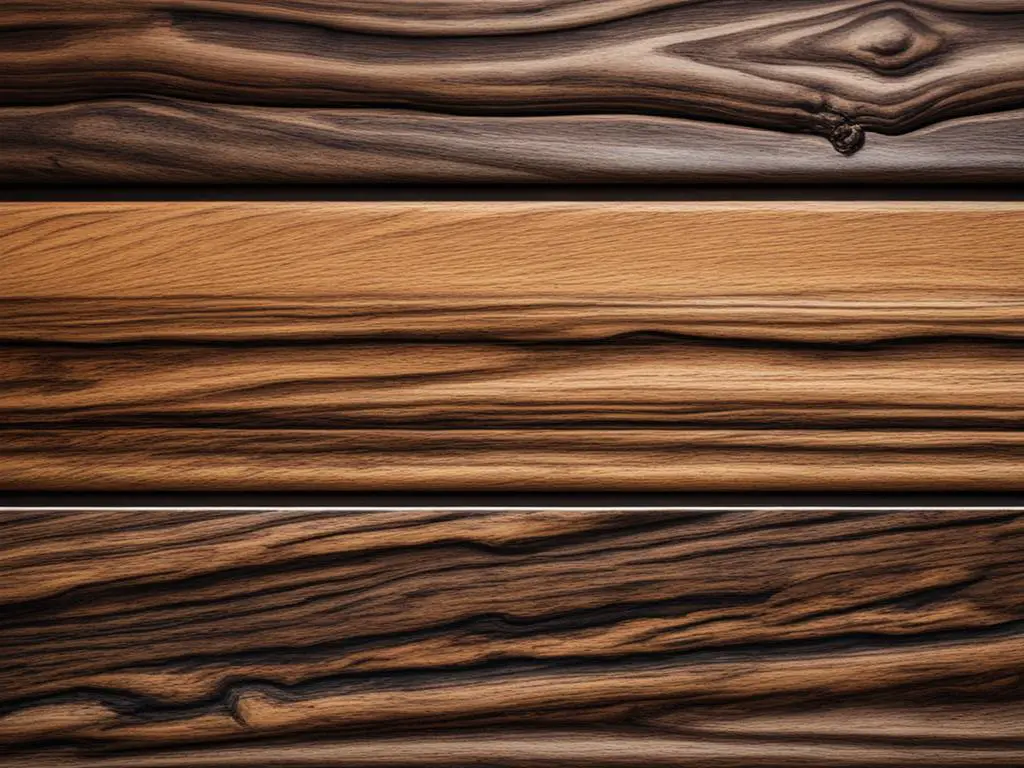When it comes to choosing the right wood stain for your projects, special walnut and dark walnut are two popular options. Special walnut has a warm, medium brown tone that works well with rustic and homey designs, while dark walnut offers a sleek dark brown color with golden highlights, perfect for a sophisticated and timeless aesthetic. Both stains have their own unique charm and will pair better with specific styles in certain interiors. In this comparison, we will explore the benefits, drawbacks, and applications of both special walnut and dark walnut stain.
Key Takeaways:
- Special walnut has a warm, medium brown tone, while dark walnut offers a dark brown color with golden highlights.
- Special walnut works well with rustic and homey designs, while dark walnut adds a touch of elegance to any wood project.
- Dark walnut stain is better at masking stains and dirt, making it suitable for high-traffic areas.
- Special walnut stain is versatile and fits well with a variety of color schemes and design styles.
- Choosing between special walnut and dark walnut stain depends on personal preference, the wood species used, and the desired ambiance of the space.
Benefits of Dark Walnut Stain
Dark walnut stain is a popular choice for homeowners and designers due to its numerous benefits. From its unique appeal to its practical advantages, there are several reasons why dark walnut stain is a top pick for wood projects.
Enhanced Aesthetic Appeal
One of the key benefits of dark walnut stain is its ability to add a touch of opulence to any wood surface. The dark brown color with golden highlights creates a timeless and elegant look that can elevate the overall aesthetic of any space. Whether used for furniture, cabinetry, or flooring, dark walnut stain brings a sense of sophistication and luxury to the forefront.
Masking Stains and Dirt
Dark walnut stains are specifically designed to effectively mask stains and dirt, making them an ideal choice for high-traffic areas or homes with pets and children. The dark color helps to camouflage any spills or marks, keeping your wood surfaces looking clean and presentable for longer periods of time. This makes dark walnut stain a practical option for those seeking low-maintenance wood finishes.
Timeless Durability
When it comes to longevity, dark walnut stain stands the test of time. It is highly resistant to fading, even when exposed to sunlight. This means that your wood surfaces will maintain their rich and beautiful color for years to come, ensuring that your investment in dark walnut stain is worthwhile. Its durability makes it a reliable choice for both interior and exterior wood projects.
“Dark walnut stain brings a touch of opulence and elegance to any wood project, while also delivering practical benefits such as stain and dirt resistance.”
However, it’s important to note that dark walnut stains have a few considerations. They are prone to scratches, so extra care must be taken to protect the surface from potential damage. Additionally, using dark walnut stain in smaller spaces may create a visually compact feel. Lastly, light-colored dirt may not be effectively hidden due to the darker nature of the stain.

In summary, dark walnut stain offers a unique and opulent appeal to wood projects, while also providing practical benefits such as stain and dirt resistance. Its durability ensures that your wood surfaces will maintain their beauty over time. However, it is important to consider the potential for scratches, its visual impact in smaller spaces, and its limitations in hiding light-colored dirt. Overall, dark walnut stain is an excellent choice for those looking to add sophistication and functionality to their wood surfaces.
Benefits of Special Walnut Stain
Special walnut stain is a popular choice for wood projects due to its numerous benefits. Whether you’re working on furniture, flooring, or other wooden surfaces, special walnut stain offers a warm and inviting brown tone that effortlessly blends with various color schemes and design styles. Its versatility allows you to create both elegant and cozy designs, making it suitable for a range of interior settings.
When applied to hardwood floors, special walnut stain adds a rustic charm that enhances the overall aesthetic of any space. Its natural earthy appeal brings warmth and character, making your floors stand out and creating a welcoming atmosphere.
In addition to its visual appeal, special walnut stain also offers practical advantages. It can increase the value of your home and furniture by providing a durable and long-lasting finish. With proper sealing, special walnut stain can protect your wooden surfaces from scratches and wear, ensuring their beauty and integrity for years to come.
While special walnut stain may have a less polished and elegant appearance compared to dark walnut stain, it compensates with its versatility, charm, and durability. With special walnut stain, you can achieve a timeless and stylish look that complements a wide range of design styles and adds value to your wood projects.
Consider using special walnut stain when you want to create a warm and inviting atmosphere in your space, enhance the beauty of hardwood floors, or add a touch of rustic charm to your furniture. Its benefits and aesthetic appeal make it a popular choice among homeowners and designers alike.

The Versatility of Special Walnut Stain
Special walnut stain is known for its versatility and ability to complement a variety of color schemes and styles. Whether you’re going for a traditional, contemporary, or transitional design, special walnut stain can effortlessly adapt and enhance the overall aesthetic of your space.
Its warm brown tone adds depth and richness to any wood surface, creating a cozy and welcoming ambiance. Special walnut stain can be applied to different types of wood, including oak, cherry, and pine, allowing you to achieve the desired look and feel for your project.
Furthermore, special walnut stain can be easily combined with other stains or finishes to create unique and personalized effects. Whether you prefer a darker or lighter shade, you can customize the intensity of the stain to match your design vision.
With special walnut stain, the possibilities are endless. From furniture to flooring, this versatile stain can transform your wood projects into stunning works of art.
Key Differences between Special Walnut and Dark Walnut Stain
When it comes to choosing the perfect stain for your wood projects, understanding the differences between special walnut and dark walnut stain is essential. These two stains have distinctive characteristics that can greatly impact the visual appeal of your finished piece. Let’s take a closer look at the key differences between special walnut and dark walnut stain:
1. Color Tones
Special walnut stain offers a warm, medium brown color tone, creating a cozy and inviting atmosphere. On the other hand, dark walnut stain delivers a darker, sleek brown shade with golden highlights, which adds a touch of sophistication to any wood project.
2. Grain Enhancement
Both special walnut and dark walnut stain enhance the natural grain of the wood, emphasizing its unique patterns and textures. However, special walnut stain, being a lighter shade, tends to show a more pronounced grain pattern compared to dark walnut stain.

3. Design Compatibility
Special walnut stain is incredibly versatile and pairs well with various design styles, including traditional, contemporary, and transitional. Its warm brown tone adds character and blends seamlessly with different color schemes. On the other hand, dark walnut stain is particularly suited for rustic, farmhouse, and vintage-inspired interiors, where it creates a timeless and charming ambiance.
4. Personal Preference and Wood Species
The choice between special walnut and dark walnut stain ultimately comes down to personal aesthetic preferences and the type of wood being used. Consider the existing decor and the desired visual impact when deciding which stain to use. Some wood species may better complement special walnut stain, while others may benefit from the richness of dark walnut stain.
5. Visual Impact
Special walnut stain offers a warm and inviting visual impact, perfect for creating a cozy and comforting atmosphere. Dark walnut stain, on the other hand, adds a touch of elegance and sophistication to any space, making it ideal for more formal or luxurious settings.
| Characteristics | Special Walnut Stain | Dark Walnut Stain |
|---|---|---|
| Color Tone | Warm, medium brown | Darker, sleek brown with golden highlights |
| Grain Enhancement | More pronounced grain pattern | Less pronounced grain pattern |
| Design Compatibility | Versatile – works well with traditional, contemporary, and transitional designs | Suited for rustic, farmhouse, and vintage-inspired interiors |
| Personal Preference | Warm and inviting | Elegant and sophisticated |
Ultimately, the choice between special walnut and dark walnut stain relies on your personal taste, the desired ambiance, and the specific characteristics of the wood species you are working with. Each stain brings its own unique visual impact that can elevate the overall look of your wood projects.
Conclusion
After comparing the benefits and characteristics of special walnut and dark walnut stain, it is clear that the choice between the two ultimately depends on personal preference and design goals. Both stains have their own unique qualities that can enhance the beauty of wood surfaces.
Special walnut stain offers a warm and versatile tone that complements various styles, making it a popular choice for many homeowners. Its medium brown color works well with rustic and homey designs, adding a cozy and inviting feel to the space. On the other hand, dark walnut stain exudes elegance and opulence with its sleek dark brown color and golden highlights. It is perfect for creating a sophisticated and timeless aesthetic.
When deciding which stain to choose, consider the existing decor, the type of wood being used, and the desired atmosphere. Special walnut stain is ideal for incorporating a touch of warmth and versatility, while dark walnut stain adds a sense of luxury and richness to the overall design. Additionally, remember to protect the stained wood by applying a clear coat or finish to maintain its luster over time.
In conclusion, when it comes to choosing the right stain for your wood projects, special walnut and dark walnut stain both offer their own unique charm. By considering your personal taste and design vision, you can select the perfect stain that brings out the natural beauty of the wood and enhances the overall aesthetic of your space.
FAQ
What is the difference between special walnut and dark walnut stain?
Special walnut stain has a warm, medium brown tone, while dark walnut stain offers a sleek dark brown color with golden highlights.
What are the benefits of dark walnut stain?
Dark walnut stain adds a touch of opulence, masks stains and dirt well, has a timeless and elegant look, but may be prone to scratches and make a room appear smaller.
What are the benefits of special walnut stain?
Special walnut stain has a warm brown tone that fits well with various color schemes and design styles, adds a rustic charm, and can increase the value of homes and furniture. However, it may require a sealant for long-term protection.
What are the key differences between special walnut and dark walnut stain?
The main difference lies in their tones, with special walnut having a warmer, medium brown color and dark walnut offering a darker, sleek brown with golden highlights. Special walnut works well with traditional and contemporary designs, while dark walnut is suited for rustic and farmhouse interiors.
How do I choose between special walnut and dark walnut stain?
The choice depends on personal preference, existing decor, the wood species used, and the desired atmosphere. Consider the aesthetic preferences and the ambiance of the space when selecting the perfect stain.
Do I need to apply a clear coat or finish to the stained wood?
Yes, to protect the stained wood and maintain its luster over time, it is recommended to apply a clear coat or finish.



